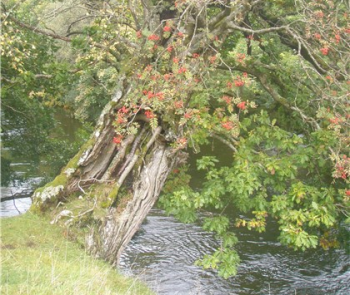Identifying Trees

On Friday 7 August 2015, the
Friends of the Lake District and the Mountain
Training Association organised a Tree Identification Workshop led by Pete Leeson, Woodland Creation Adviser for
The Woodland Trust. This interesting and informative day took place at ‘The Helm’ woods, near Kendal, Cumbria. The Helm is partly owned and managed by the Friends of the Lake District who have planted 1,500 native trees to create habitat and enhance people’s enjoyment. The aim of the workshop was to learn how to identify the wide variety of tree species on the site and pass on this knowledge to others when in different outdoor locations.
Pete asked us to think about Woodlands and why trees were all different heights, shapes and sizes. Some species grow faster than others whilst some species live for a long time but only grow to a certain height. Variations in geology, soil types and moisture will all affect the types of trees we are likely to find there. You will have noticed how trees are smaller at the top of hills/fells than at the bottom.
He asked us to look at the trees from a distance and to specifically look at the various tree colours, in particular Lime Trees, how much lighter they are than other trees and that the leaf has a sharp point on the very end. The nearest companion to a Lime Tree is a Hazel and the leaves can be confused, however, he showed us that the Lime Leaf can have ‘hairy armpits’ whereas a hazel doesn’t. Lime Trees are good pollinators for bees because of their flowers and they have “helicopter like” seeds, similar to Sycamore seeds. The leaves of Sycamore Trees are similar to the Canadian Flag and cause a lot of shade. In winter, no flora is found under a Sycamore Tree whereas there is under a Rohan Tree. He described how Rohan Tree seeds (the berry) are distributed by birds while Birch Tree seeds are carried by the wind. We looked at the similarities between the leaves of the Ash, Rowan and Elder trees and how the Ash can be identified by their black buds. We also looked at the different barks on trees and their textures, Pete described the bark on Rohan Trees as looking like ‘scrunched up stockings’.
Pete described how oak trees shrink as they get older and shed their lower limbs. He also explained that the oak tree is one of the most important tree types as over 400 species live on it including Gall Wasps, Midges and Blue Bottles. Beech trees create a lot of shade and have big buttressing roots, however they are not very good for biodiversity. Brambles are good for tree tube protection and Barn Owls like them because of their berries. Red Campion is a pink flower associated with the woodlands and they have black seeds inside their “poppy like” seed head. Children find it interesting to see the seeds inside the seed head. The seed heads of blue bells can be opened up in the same way.

I thoroughly enjoyed my day at the Tree Identification Workshop and I was soon able to pass on my knowledge to children and parents during the “Mini Trekkers” events which I led for the Lake District National Park in August. The Mini Trekkers event is a gentle, nature themed, family activity walk suitable for children aged 3 to 8 and I incorporated the Tree Leaf Identification into one of the activities. I would highly recommend the Tree Identification Workshop to anyone leading events in the outdoors or working towards their Mountain Leader award. The Woodland Trust also produce an excellent waterproof pocket leaf identification guide. Visit the
Woodland Trust for more information.
Sue Glover
Volunteer Event Leader for
Lake District National Park Authority
Volunteer Lengthsmen for
Fix the Fells
Mountain Leader Trainee